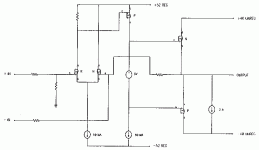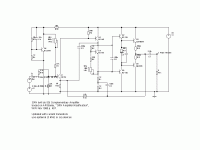Extraordinary!
Cambridge audio is based in the most cosmopolitan city in the world, but is, it would appear, a resolutely ''caucasians-only'' organisation. Hello!?!
Incidentally, D. Self is in the front row, third from the left (bespectacled).
Cambridge audio is based in the most cosmopolitan city in the world, but is, it would appear, a resolutely ''caucasians-only'' organisation. Hello!?!

Incidentally, D. Self is in the front row, third from the left (bespectacled).
I mean, front row 4th from left invalidates your claim of an all-caucasian company...
Jan Didden
Jan Didden
well, i see maybe four but certainly no one that looks like me ...
🙁
mlloyd1
🙁
mlloyd1
mikeks said:Just one!?
mikeks said:Just one!?
Divided by your zero it's an infinitely high ratio ...😀
Jan Didden
Hi all
Another thought ...
Back in 1968 Arthur Bailey published a circuit for one of the first complementary power amplifiers. Anyone remember this? It appeared as "30 W modification" to his Wireless World 30 W circuit, and republished in "High Fidelity Designs" in 1970. It had 40361, 40362, MJ481 and MJ491 in the line-up.
It is a most interesting design because it did not have the usual feedback decoupling capacitor in the input stage. Instead it used a thermal bias compensation transistor. The feedback resistor was taken from the output rail, sitting at around 30V, down to near ground through the un-decoupled feedback attenuator (gain) resistor. Bailey said "if anything, this amp. runs better than the original". I took a look at this some time ago and realised that the current taken by the feedback resistor (1.5kohms) forced the upper output stage into class A. This according to my simulations reduced the crossover distortion a little.
Predating XD?
cheers
John
Another thought ...
Back in 1968 Arthur Bailey published a circuit for one of the first complementary power amplifiers. Anyone remember this? It appeared as "30 W modification" to his Wireless World 30 W circuit, and republished in "High Fidelity Designs" in 1970. It had 40361, 40362, MJ481 and MJ491 in the line-up.
It is a most interesting design because it did not have the usual feedback decoupling capacitor in the input stage. Instead it used a thermal bias compensation transistor. The feedback resistor was taken from the output rail, sitting at around 30V, down to near ground through the un-decoupled feedback attenuator (gain) resistor. Bailey said "if anything, this amp. runs better than the original". I took a look at this some time ago and realised that the current taken by the feedback resistor (1.5kohms) forced the upper output stage into class A. This according to my simulations reduced the crossover distortion a little.
Predating XD?
cheers
John
Hi Lumenauw
Here's a revised circuit (not quite the same) but the feedback resistor clearly operates in the "XD" mode, I think.
cheers
John
Here's a revised circuit (not quite the same) but the feedback resistor clearly operates in the "XD" mode, I think.
cheers
John
The work of Nelson Pass appear appliying ante litteram "XD" principle while the same can't be told about the Bayley circuit.
However... I, without any claim of inventing anything of new (because there is NOTHING of new in these things), just apply this "new class" from a dozen of years in forcing some of my op-amp circuits to work in class A in not extreme loading condtion. I'm just amazed of the rumors on what, at the end of story, is just a very *trivial* (and somewhat unelegant) idea... Is just a trick, not a "new class".
Hi
Piercarlo
However... I, without any claim of inventing anything of new (because there is NOTHING of new in these things), just apply this "new class" from a dozen of years in forcing some of my op-amp circuits to work in class A in not extreme loading condtion. I'm just amazed of the rumors on what, at the end of story, is just a very *trivial* (and somewhat unelegant) idea... Is just a trick, not a "new class".
Hi
Piercarlo
- Status
- Not open for further replies.
- Home
- Amplifiers
- Solid State
- Class XD....




